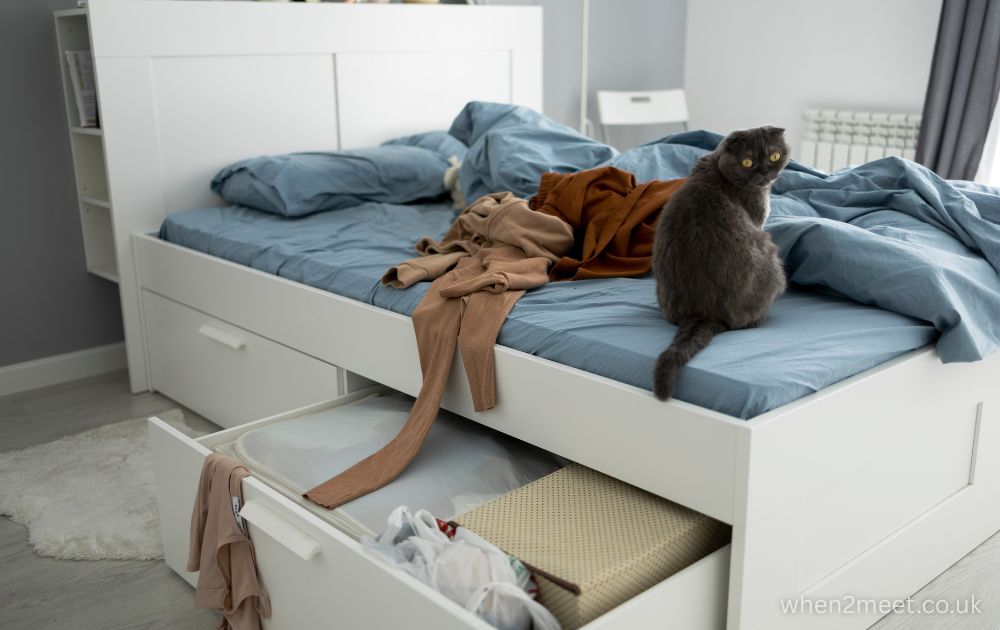The Japandi design trend beautifully merges the calm minimalism of Japanese interiors with the cozy functionality of Scandinavian design. A Japandi bed represents this fusion perfectly, creating a bedroom space that feels serene, clutter-free, and inviting.
What Makes a Japandi Bed Special?
A Japandi bed stands out for its calm simplicity and thoughtful design. It blends the warmth of Scandinavian coziness with the elegance of Japanese minimalism, creating a space that feels both soothing and inviting. With clean lines, natural materials, and a soft neutral palette, these beds are more than furniture, they’re a reflection of balance and harmony. Choosing a Japandi bed means bringing a sense of peace into your bedroom, where every detail is designed to promote comfort and mindfulness.
Key Features of a Japandi Bed Frame
The Japandi bed frame often showcases clean lines, natural wood, and a grounded look.
-
Crafted from solid oak or bamboo
-
Low to the ground for a grounded, calming feel
-
Neutral shades to complement minimalist interiors
Japandi Platform Bed: Simplicity Meets Functionality
A Japandi platform bed is the perfect example of beauty in simplicity. With its clean lines and low profile, it creates a calm, grounded feeling in the bedroom. The design is intentionally minimal, yet practical, removing unnecessary bulk while offering a sturdy, comfortable base. Many styles also include hidden storage, making them ideal for modern living where space matters. More than just a frame, it’s a thoughtful piece that blends function and serenity, helping you turn your room into a peaceful retreat.
Japandi Bedding Choices
To complete the look, Japandi bedding plays an essential role.
-
Choose breathable fabrics like linen or organic cotton
-
Stick to earthy neutrals, soft whites, and muted greys
-
Layer lightweight blankets and duvets for texture and warmth
Japandi Style Bed Accessories
Accessories bring warmth without overwhelming the space.
-
A couple of throw pillows in soft tones
-
A textured blanket at the foot of the bed
-
Minimalist bedside lamps with warm light
Materials Commonly Used in Japandi Beds
Japandi design values sustainability. Beds are often made from:
-
Solid oak, ash, or bamboo
-
Eco-friendly materials and finishes
-
Recycled wood options for conscious living
Colors and Textures in Japandi Bedrooms
The Japandi palette revolves around calm, natural shades.
-
Creams, beiges, greys, and muted greens
-
Wooden textures paired with soft fabrics
-
Subtle contrast between light and dark elements
How to Style a Japandi Bed Frame in Your Bedroom
Styling a Japandi bed frame is all about creating calmness and balance. Keep the space clutter-free, add a touch of nature with plants, and layer soft fabrics for warmth. Pair natural wood with neutral tones to achieve a serene and timeless atmosphere.
Japandi Platform Bed vs. Traditional Beds
A Japandi platform bed stands apart from traditional designs with its low, streamlined profile and focus on simplicity. While conventional beds often feature bulky headboards, heavy frames, or ornate details, Japandi beds embrace minimalism and natural elegance. Their grounded design creates a calming, spacious atmosphere, making the room feel lighter and more open. In contrast, traditional beds can dominate a space, whereas Japandi platform beds blend seamlessly with modern interiors, offering both comfort and understated beauty.
Benefits of Choosing a Japandi Bed
Choosing a Japandi bed is more than just picking furniture, it’s about creating a lifestyle of calmness, balance, and simplicity. This style doesn’t overwhelm your room but instead brings a sense of harmony and comfort. Here are some gentle benefits that make it a beautiful choice:
-
Encourages relaxation: The soft lines, natural wood, and cozy bedding help you unwind after a long day.
-
Timeless style: Japandi beds never go out of trend; they blend seamlessly with both modern and classic interiors.
-
Eco-friendly living: Often made from sustainable materials like bamboo or oak, they support a greener lifestyle.
-
Space-friendly design: With their low-profile and minimalist frame, Japandi beds make even small rooms feel open and airy.
-
Long-lasting quality: Crafted from durable natural wood, these beds are built to serve you for years with little maintenance.
Tips for Buying a Japandi Bed
-
Prioritize quality materials: Choose solid wood like oak, ash, or bamboo for durability and authenticity.
-
Match size with room space: Select a bed frame proportionate to your bedroom for balance and openness.
-
Stick to minimalist designs: Look for clean lines, low profiles, and clutter-free frames.
-
Coordinate with Japandi décor: Ensure the bed blends seamlessly with other furniture and colors in your room.
-
Consider sustainability: Opt for eco-friendly or recycled wood options to align with Japandi values.
-
Test comfort and stability: Make sure the frame feels sturdy and supports restful sleep.
Budget-Friendly Japandi Bed Ideas
Creating a Japandi bedroom doesn’t have to be expensive.
-
DIY simple wooden bed frames
-
Use second-hand or upcycled wood
-
Buy affordable linen-look bedding
Japandi Bedrooms for Small Spaces
Designing a Japandi bedroom in a smaller space is all about balance and intention. A Japandi platform bed works wonderfully here, as its low and sleek profile creates the illusion of openness while keeping the room airy. Choosing multifunctional pieces, like beds with built-in storage or compact bedside tables, helps maintain a clutter-free atmosphere. Soft neutral tones, natural light, and a touch of greenery can make even the tiniest bedroom feel calm, inviting, and beautifully harmonious.
Conclusion
A Japandi bed is more than just a piece of furniture, it’s a statement of simplicity, mindfulness, and timeless elegance. By choosing Japandi-style designs, you create a calming retreat that encourages relaxation and brings balance to your home.
Read More interesting topic: Kids Double Bed
FAQs About Japandi bed
Q1: What is a Japandi bed?
A Japandi bed combines Japanese minimalism with Scandinavian coziness, focusing on clean lines, natural materials, and comfort.
Q2: What materials are best for Japandi bed frames?
Solid oak, ash, and bamboo are commonly used for their durability and natural beauty.
Q3: How do I style Japandi bedding?
Opt for neutral shades, breathable fabrics, and layering techniques to achieve a cozy yet simple look.
Q4: Is a Japandi platform bed good for small bedrooms?
Yes, platform beds save space, provide storage options, and keep the room feeling airy.
Q5: Can I create a Japandi bed setup on a budget?
Absolutely—DIY wooden frames, thrift finds, and affordable bedding alternatives can help achieve the look without overspending.










